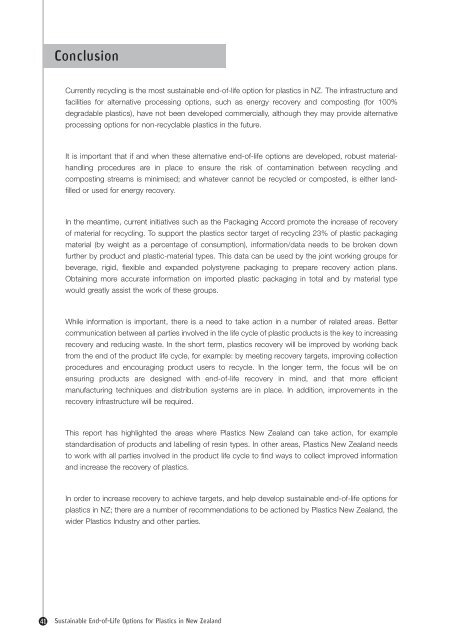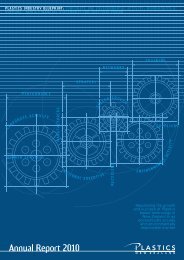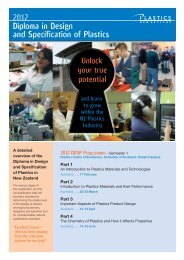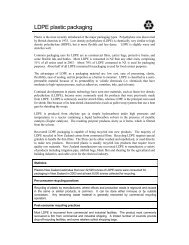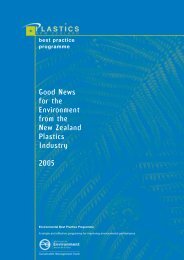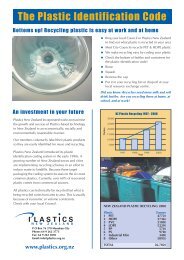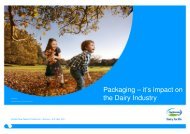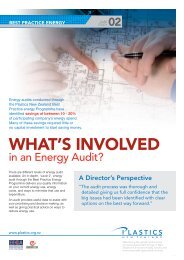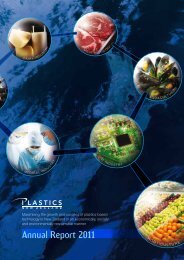Sustainable End-of-Life Options for Plastics in New Zealand
Sustainable End-of-Life Options for Plastics in New Zealand
Sustainable End-of-Life Options for Plastics in New Zealand
Create successful ePaper yourself
Turn your PDF publications into a flip-book with our unique Google optimized e-Paper software.
Conclusion<br />
Currently recycl<strong>in</strong>g is the most susta<strong>in</strong>able end-<strong>of</strong>-life option <strong>for</strong> plastics <strong>in</strong> NZ. The <strong>in</strong>frastructure and<br />
facilities <strong>for</strong> alternative process<strong>in</strong>g options, such as energy recovery and compost<strong>in</strong>g (<strong>for</strong> 100%<br />
degradable plastics), have not been developed commercially, although they may provide alternative<br />
process<strong>in</strong>g options <strong>for</strong> non-recyclable plastics <strong>in</strong> the future.<br />
It is important that if and when these alternative end-<strong>of</strong>-life options are developed, robust materialhandl<strong>in</strong>g<br />
procedures are <strong>in</strong> place to ensure the risk <strong>of</strong> contam<strong>in</strong>ation between recycl<strong>in</strong>g and<br />
compost<strong>in</strong>g streams is m<strong>in</strong>imised; and whatever cannot be recycled or composted, is either landfilled<br />
or used <strong>for</strong> energy recovery.<br />
In the meantime, current <strong>in</strong>itiatives such as the Packag<strong>in</strong>g Accord promote the <strong>in</strong>crease <strong>of</strong> recovery<br />
<strong>of</strong> material <strong>for</strong> recycl<strong>in</strong>g. To support the plastics sector target <strong>of</strong> recycl<strong>in</strong>g 23% <strong>of</strong> plastic packag<strong>in</strong>g<br />
material (by weight as a percentage <strong>of</strong> consumption), <strong>in</strong><strong>for</strong>mation/data needs to be broken down<br />
further by product and plastic-material types. This data can be used by the jo<strong>in</strong>t work<strong>in</strong>g groups <strong>for</strong><br />
beverage, rigid, flexible and expanded polystyrene packag<strong>in</strong>g to prepare recovery action plans.<br />
Obta<strong>in</strong><strong>in</strong>g more accurate <strong>in</strong><strong>for</strong>mation on imported plastic packag<strong>in</strong>g <strong>in</strong> total and by material type<br />
would greatly assist the work <strong>of</strong> these groups.<br />
While <strong>in</strong><strong>for</strong>mation is important, there is a need to take action <strong>in</strong> a number <strong>of</strong> related areas. Better<br />
communication between all parties <strong>in</strong>volved <strong>in</strong> the life cycle <strong>of</strong> plastic products is the key to <strong>in</strong>creas<strong>in</strong>g<br />
recovery and reduc<strong>in</strong>g waste. In the short term, plastics recovery will be improved by work<strong>in</strong>g back<br />
from the end <strong>of</strong> the product life cycle, <strong>for</strong> example: by meet<strong>in</strong>g recovery targets, improv<strong>in</strong>g collection<br />
procedures and encourag<strong>in</strong>g product users to recycle. In the longer term, the focus will be on<br />
ensur<strong>in</strong>g products are designed with end-<strong>of</strong>-life recovery <strong>in</strong> m<strong>in</strong>d, and that more efficient<br />
manufactur<strong>in</strong>g techniques and distribution systems are <strong>in</strong> place. In addition, improvements <strong>in</strong> the<br />
recovery <strong>in</strong>frastructure will be required.<br />
This report has highlighted the areas where <strong>Plastics</strong> <strong>New</strong> <strong>Zealand</strong> can take action, <strong>for</strong> example<br />
standardisation <strong>of</strong> products and labell<strong>in</strong>g <strong>of</strong> res<strong>in</strong> types. In other areas, <strong>Plastics</strong> <strong>New</strong> <strong>Zealand</strong> needs<br />
to work with all parties <strong>in</strong>volved <strong>in</strong> the product life cycle to f<strong>in</strong>d ways to collect improved <strong>in</strong><strong>for</strong>mation<br />
and <strong>in</strong>crease the recovery <strong>of</strong> plastics.<br />
In order to <strong>in</strong>crease recovery to achieve targets, and help develop susta<strong>in</strong>able end-<strong>of</strong>-life options <strong>for</strong><br />
plastics <strong>in</strong> NZ; there are a number <strong>of</strong> recommendations to be actioned by <strong>Plastics</strong> <strong>New</strong> <strong>Zealand</strong>, the<br />
wider <strong>Plastics</strong> Industry and other parties.<br />
41 <strong>Susta<strong>in</strong>able</strong> <strong>End</strong>-<strong>of</strong>-<strong>Life</strong> <strong>Options</strong> <strong>for</strong> <strong>Plastics</strong> <strong>in</strong> <strong>New</strong> <strong>Zealand</strong>


